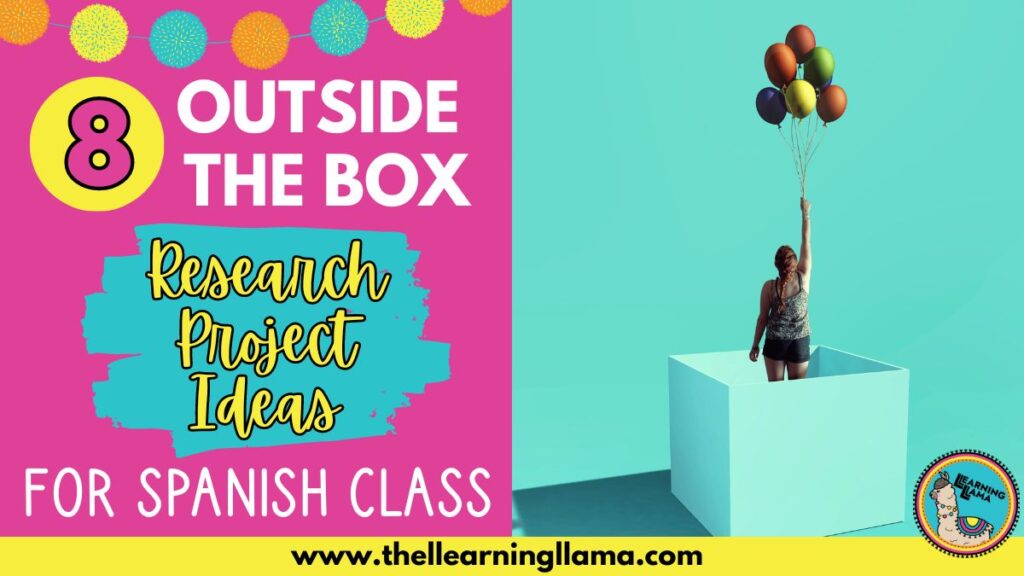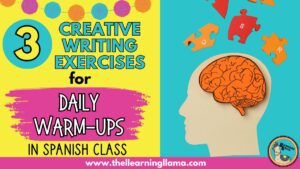Research projects can be done at any point of the school year. They make great sub plans, independent work, group projects, final projects, and more. And they do not have to be the same old, boring research projects that students think of… a PowerPoint presentation, a trifold poster, a brochure. Let’s give students some unique options with these research project ideas.
Here are some research project topic ideas for Spanish class:

Geography
- The 7 Wonders of the Hispanic World – From Machu Picchu to La Alhambra and everywhere in between, check out this blog post with tons of ideas for 7 amazing sites!
- Individual Country Projects – Assign each student a Spanish-speaking country and they report on the food, customs, geography, music, people, etc.
Famous People
- Women’s History Month – check out this blog post to grab a freebie list of Hispanic women
- Hispanic Heritage Month – Here is a list of famous Hispanics organized by category: authors, artists, activists, etc.
Animals
- Endangered Animals – Unfortunately, there are many endangered species in Latin America. Your students can choose one to research and explain why it is in danger of extinction. This usually ties in perfectly with global challenges: pollution, climate change, etc.
- Animals from Hispanic Countries – There are plenty of other animals not in danger of extinction. And all students seem to love a unit on animals. Learn about my unit on animals and grab some research project ideas from the blog post.
Food
- Authentic dishes from Hispanic countries – Assign each student a country to research the most common and traditional foods from that country. Students could report on ingredients, preparation steps, when it is eaten, etc.
- Street Foods – Everybody loves pizza, hotdogs, funnel cakes, and more. But what are common street foods in Latin America? Have your students do some research to find out. They can even create a mini food truck festival and bring in samples of their food if you’re feeling adventurous!
Authentic Travel
Research as if you were traveling to a country and prepare for your trip. Plan every step of the way, including airfare, hotels, transportation, etc. Then, plan a detailed itinerary with attractions along the way! Here are some guidelines for student-led virtual field trips or webquests.
Types of Research Projects

Research Posters
This can be done two ways for differentiation. The first is to simply give your students the freedom to design their own poster. After assigning the research topic, provide students with large construction paper and let them get to work. You should provide some guidelines including the requirements of information that you want them to research, but the overall layout and design is up to them. If you are short on time or want consistency, provide them with a generic poster that they simply fill in the information. Here are some examples that I have created:
- 48 Hispanic Heritage Month People
- 25 Animals of Central and South America
- 7 Wonders of the Hispanic World
- 25 Traditional Hispanic Foods
- 25 Women’s History Month Hispanics
- 20 Hispanic Music Genres
- 25 Hispanic Celebrations
- MEGA BUNDLE of 150 HISPANIC POSTERS

Create an Infographic
Similar to a poster, but this gives students the opportunity to design something digitally. I recommend using Canva, it is my favorite design website, and it is completely free! Here is a blog post about why I love using Canva with my students and how they can use it to design their own infographics or other projects. Infographics are a visual representation of text. It is a great way for students to summarize their research in a way that is accessible to their classmates. As students create, they summarize in brief text and with images. Then, when their classmates look at the infographics, they are not deciphering a bunch of text in the target language, but can glance quickly and still get the main ideas.
Socratic Seminar
My favorite way to use a Socratic Seminar involves turning it into a competition. Simply having a conversation in a circle always seems to intimidate my students and bore the ones tasked with listening. BUT if you turn it into a competition, something worth fighting for, suddenly the conversations are elevated and lively.
Provide the research topic: endangered animal, famous Hispanic person, best attraction, etc. Students will choose one and research it. You should provide some guiding questions and even a graphic organizer. Then, to present their research, students will sit in a small circle with 3-5 students, while the remaining students sit in a larger outside circle. The inner circle debates the topic with a twist of competition.
Instead of “discuss your endangered animals” – how about “The WWF has funding to save one animal. Which endangered animal deserves to be saved?” Students must defend their animal and explain why it is the most deserving of life.
Instead of “talk about the accomplishments of the Hispanic person,” – “You are all in an airplane that is malfunctioning, and there is only one parachute. Who deserves it the most? Who can make/has made the most impact on the world?” This idea comes from the only textbook that I thought was worth saving from my Masters in Foreign Language Teaching Program – “Intercultural Language Activities” by John Corbett. It is filled with practical intercultural activities for 14 cultural areas.
Instead of “discuss the famous attractions you researched,” – “If someone just won the lottery and had to pick a vacation, where should they go, and why.”
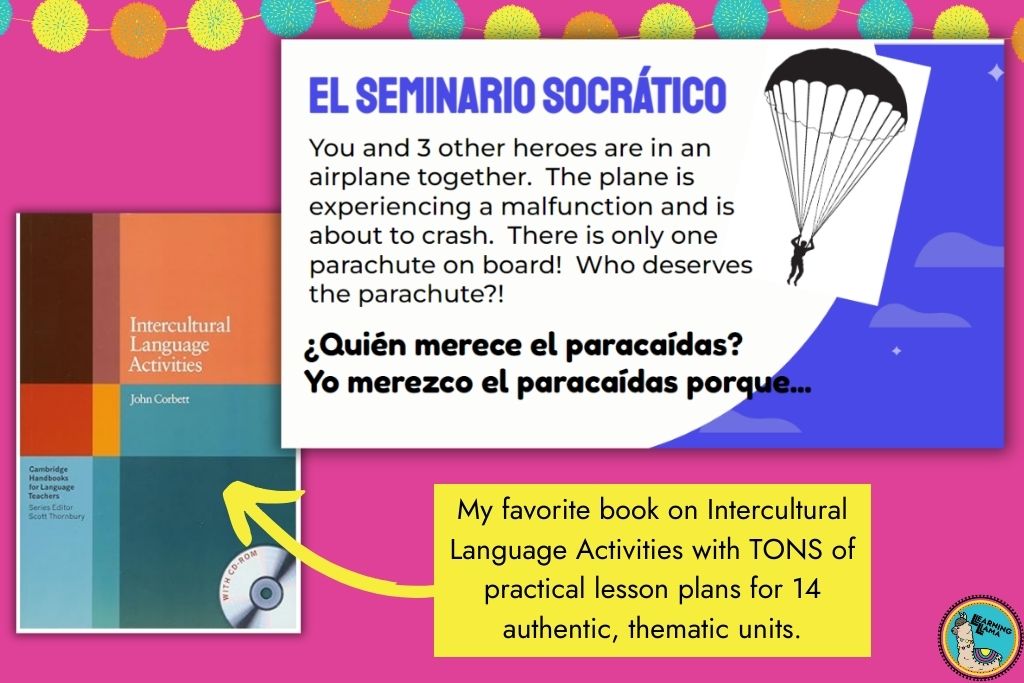
Gallery Walk
I did this type of research project often. It did not require a lot of time, because it does not need to be formal in terms of presentation. Each student or group is tasked with researching their chosen topic. They present their material either on a large white board (check out my $10 Home Depot hack) or a large piece of paper. Hanging or displaying their findings around the room, students can circulate to read about the other groups’ work.
My favorite way to administer a research gallery walk is to have each group of students that worked together divide themselves after the research. For example, if students worked in groups of four, two students stay at the presentation and “present” as the other students walk around the room. The other two students circulate and listen to the other, brief presentations, taking notes as they listen. Then, everybody switches roles.
Choice Boards
You can provide students with a bunch of mini research projects in a choice board format. Here are tips for designing your own choice board. Depending on your students’ level and your time frame, select how many options students must complete. Here are a few sample ideas for mini research projects: Create a 1 minute podcast episode, draw an infographic, create a mini poster or brochure, create a quiz for the class, draw a timeline, etc.
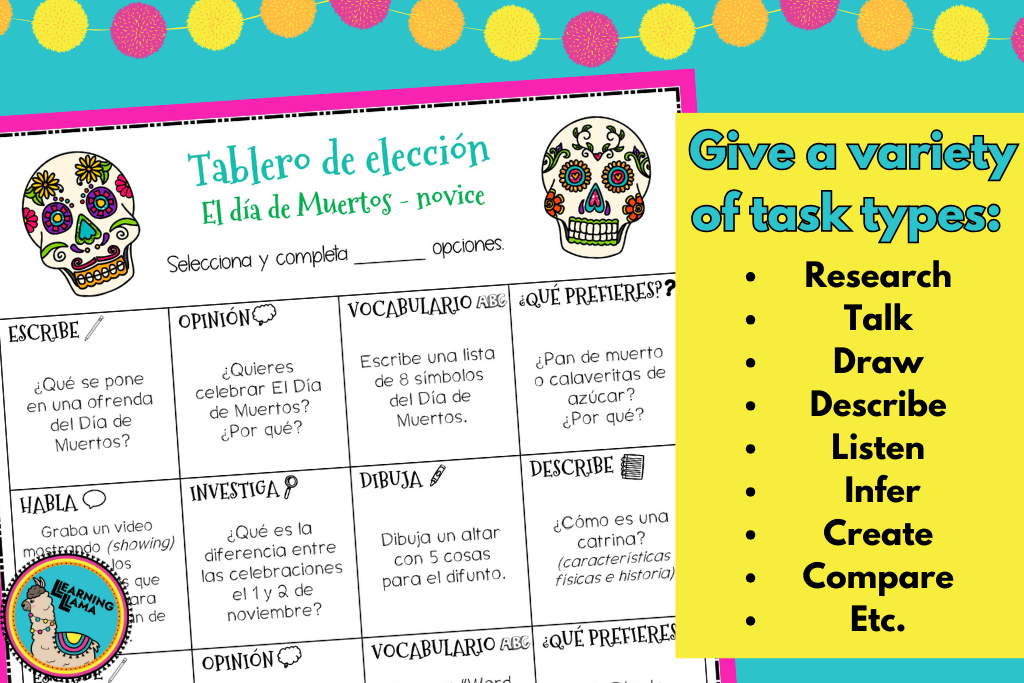
Instagram Profile
Create an Instagram profile with a few images and captions of your research findings. The goal of this is for students to not just research information, but also images and to capture a variety of images of their research. For example, if it is an endangered animal, all 6 pictures should not just be the frog sitting in the water. Encourage them to think outside the box. Maybe a picture of its habitat, a picture of its food, a picture of a map where it is located, etc.
Here are ways to use Instagram in Spanish class, including a FREE Instagram template, perfect for this idea!
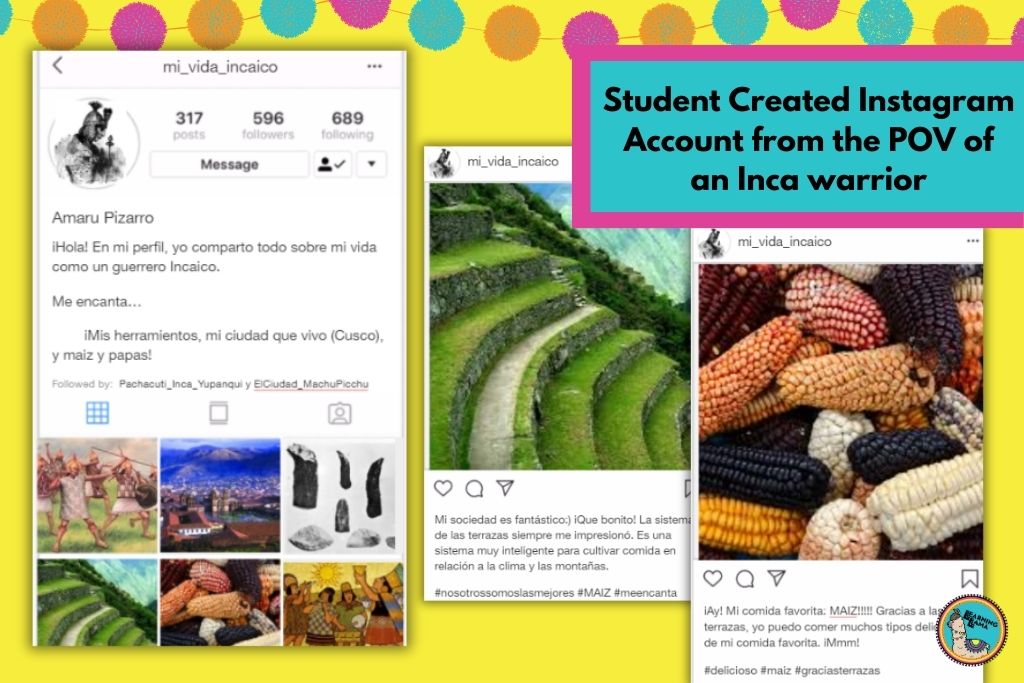

Art Gallery
Have students create an artwork that represents their findings. They could draw the animal, person, attraction, etc. and display it around the classroom like an art gallery. Then, to incorporate their research, they should write a description about it, similar to a plaque you would find next to a piece of artwork in a museum. Display the artworks and “plaques” in the art gallery of your classroom!
Podcast
This research project can be a stand-alone project, or a yearlong endeavor. I also suggest it for intermediate students and beyond. Students simply record audio of their research findings, but in a podcast format. When I taught Spanish 4, I had my students do a yearlong podcast project, where at the end of each unit or topic, they recorded a podcast episode. By the end of the year, they had an entire podcast series about their Spanish 4 learning.
For a research project, at the end of your unit, let your students research more in-depth something that was touched on or another topic of interest to them. For example, during a food unit, they can each choose a traditional Spanish dish and record an episode on where it is cooked, the ingredients, the flavors, when it is eaten, etc. These episodes are students sharing their findings in an informal presentational speaking assessment.
They can use a voice recorder app on their phones or computers. Then, for ease of presentation, I had my students upload each audio file into a Google Slides presentation. On each slide, they wrote the name of the episode title, a brief written summary, and linked the episode audio.
Grading Research Projects
Projects are unique, in that there is no “right or wrong” answer for the most part. With projects, you are assessing the content, which will be different for every student. You are also assessing the layout, organization, overall presentation, effort, etc. Rubrics are the best way to ensure fair and accurate grading. Determine the categories you will assess and decide the point value. The point value depends on the length of time required to complete the project. For a one-day assignment, you may only grade something as 15 points, but a week-long research project could be worth upwards of 100 points!
Both you and your students will enjoy these outside the box research project ideas. You will have more fun grading them, and your students will have more fun creating them! I’d love to hear how you use these ideas in your classroom. Comment below!

